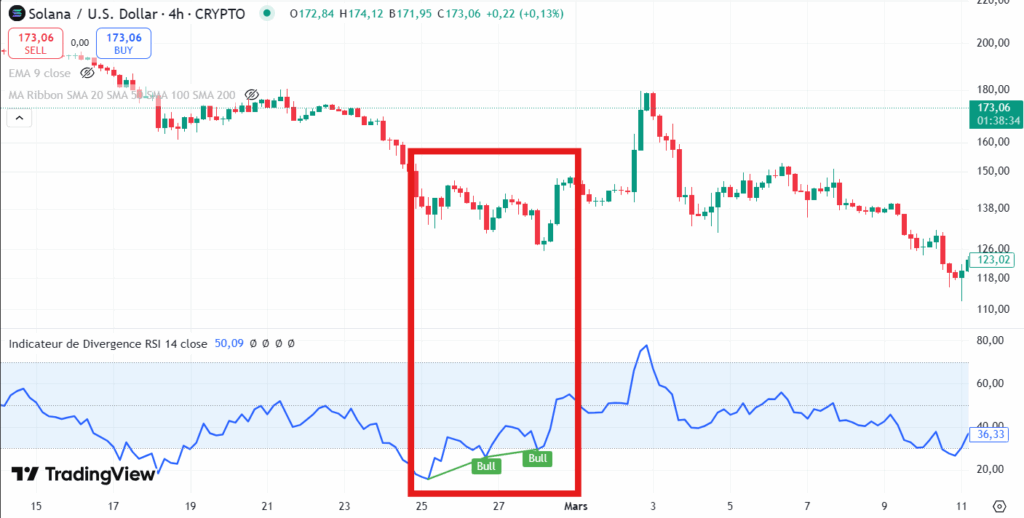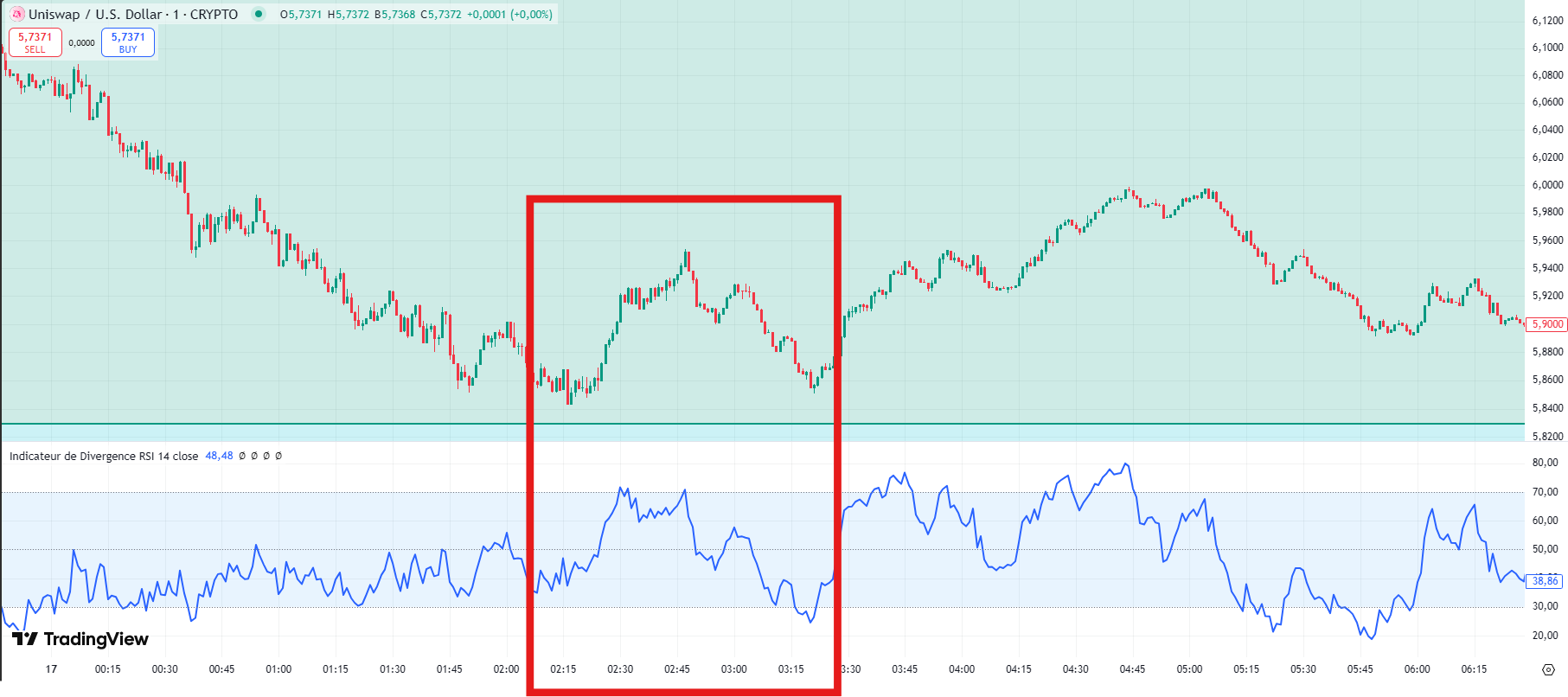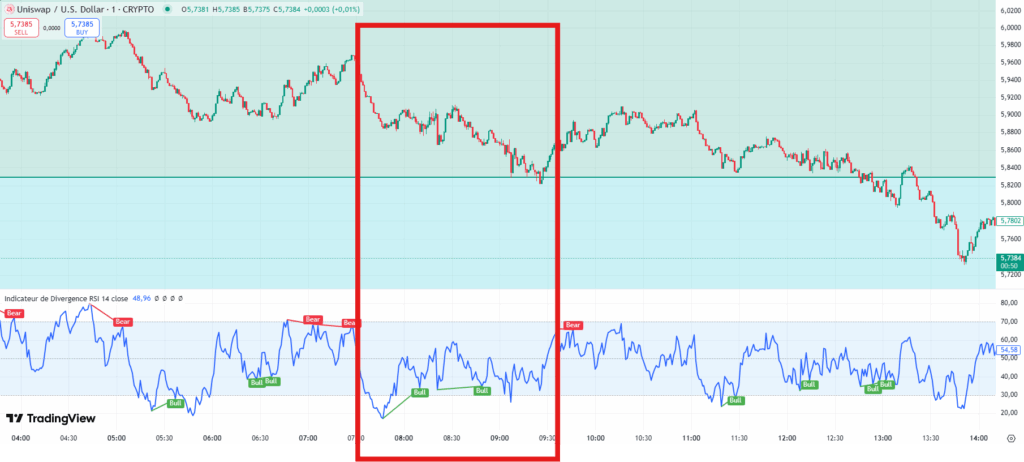RSI Haussière Diverge: Understand and exploit this signal in trading
The Haussière RSI divergence is a concept often mentioned in trading to anticipate a possible reversal of upward trend. This article presents the divergence of RSI , in particular the upward divergence , its functioning, its limits, as well as some tracks on how to use divergences in a trading strategy .
Table of contents
What is RSI divergence?
A divergence occurs when the direction of the price trend and that of the RSI are not aligned. RSI is a technical indicator widely used in technical analysis to measure the strength of a trend. It oscillates between 0 and 100, indicating the areas of surachat and the occurrence of an asset .
Concretely, a divergence appears when:
- When the price of an asset reaches a new lower or higher,
- While the RSI does not confirm this movement by displaying a lower or higher different.

This difference between price and RSI can be perceived as an alert signal, suggesting a possible change in market dynamics. The RSI of steam, which can announce a bullish reversal or the end of a downward trend . Thus, exploiting upward differences is a widespread practice among particular traders to anticipate an upward movement. There are generally two types of differences :
- Handy divergence : potential signal of a reversal to an upward trend .
- Sweet divergence : potential signal of a turnaround towards a downward trend .
Classical upward divergence and hidden upward divergence
Two main forms of bullish divergence are often distinguished:
- Classic upward divergence : the price is a lower lower, while the RSI makes a lower higher. This type of divergence is the most common and is frequently used to detect a reversal.
- Hidden divergence : it occurs when the price makes a lower higher, but the RSI makes a lower lower. This hidden divergence may indicate a possible continuation of the current upward trend

Hidden divergences are less common but can offer clues about the strength of a trend.
How to identify an RSI bullish divergence?
To exploit divergences as part of trading , it is useful to know how to identify signals on graphics by analyzing the movements of the price and the RSI . Here is a method:
- Identify the successive hollows of the price on the graph.
- Identify the corresponding hollows of the RSI over the same period.
- Compare the direction of the price of the price and RSI :
- If the price makes a lower lower and the RSI a lower higher, it corresponds to a bullish divergence .
- If the price makes a lower higher and the RSI a lower lower, it is a hidden upward divergence .
Observe when the RSI enters the occurrence area (generally in 30) can strengthen the relevance of the signal. In this context, the upward divergence is often perceived as more reliable.
Use of RSI and divergences in trading
The RSI is an indicator appreciated in the world of trading for its simplicity and relative efficiency. RSI divergences are often considered as tools to anticipate trend reversals and refine trading decisions .
Some common uses of the upward divergence RSI by traders :
- Confirmation of reversal : a bullish divergence can be interpreted as a sign that the downward trend could be reversed.
- Entering position : some traders await a bullish divergence before entering long position
- Position outing : This signal can also be perceived as an end indication of a drop phase, suggesting taking profits or limiting losses.
The divergence strategy often consists in combining reading the RSI with other indicators such as Bollinger bands , mobile averages or volumes, to improve the reliability of signals.
Example of using RSI with other indicators
To reduce the risk of false signals, an approach is to associate the RSI with:
- Mobile averages, in order to confirm the direction of the general trend.
- The supports and resistances, to identify price levels .
- The volumes, to validate the strength of the movement.
This combination of tools can help exploit divergences with more caution and precision.
Differences between upward divergence and downward divergence
The differences can be upward or lowering, each that can indicate a reversal in the opposite direction:
- Handious divergence : the price drops while the RSI increases, suggesting a possible rebound.
- Diverding divergence : the price rises while the RSI drops, signaling a risk of downward .
A downward divergence occurs when the price displays the highest highest, while the RSI displays the highest lower. This signal can be as relevant as the bullish divergence to anticipate trends .
Limits and precautions with RSI divergence
Like any indicator , the RSI and divergences do not guarantee systematic success. Some observations:
- A divergence can last a certain time before the price really reacts.
- Signals be contradicted by the force of a dominant trend, here is an example:

- Divergence trading can require rigorous risk management and well -placed stops.
- The overall context of financial markets can influence the relevance of signals.
More advanced trading often incorporates these elements to limit interpretation errors.
Integrate RSI upward divergence into a trading strategy
A method to use the RSI bullish divergence :
- Identify a downward trend on the graph.
- Identify a classic or hidden upward divergence on the RSI .
- Confirm the signal with another technical indicator (mobile average, volume, support).
- Entering a long position when the price shows signs of rebound.
- Place a stop-loss under the last hollow to limit potential losses.
- Follow the position and adjust the stop according to the evolution of the market.
This approach can help optimize entries while limiting the risks linked to false signals.
Conclusion
The RSI bullish divergence appears to be an interesting tool for detecting a potential turning back from a downward trend towards an upward trend . RSI analysis with other indicators and careful risk management, some traders can refine their trading decisions and better anticipate market movements.
To deepen the mastery of RSI and trading strategies , it can be relevant to experiment on trading platforms offering efficient graphic tools and test different combinations of indicators .
Investments in cryptocurrencies are risky. Crypternon could not be held responsible, directly or indirectly, for any damage or loss caused following the use of a property or service put forward in this article. Readers must do their own research before undertaking any action and investing only within the limits of their financial capacities. Past performance does not guarantee future results. This article does not constitute an investment .
Certain links of this article are sponsorship links, which means that if you buy a product or you register via these links, we will collect a commission on the part of the sponsored company. These commissions do not train any additional cost for you as a user and certain sponsorships allow you to access promotions.
AMF recommendations. There is no guaranteed high yield, a product with high performance potential implies a high risk. This risk taking must be in line with your project, your investment horizon and your ability to lose part of this savings. Do not invest if you are not ready to lose all or part of your capital.
All our articles are subject to a rigorous verification of the facts. Each key information is verified manually from reliable and recognized sources. When we cite a source, the link is systematically integrated into the text and highlighted by a different color, in order to guarantee transparency and allow the reader to consult the original documents directly.
To go further, read our pages legal notices , privacy policy and general conditions of use .

